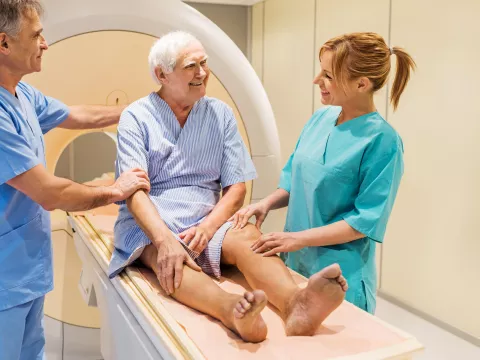- AdventHealth

Having a CT or MRI scan might seem like a pretty simple appointment — and most of the time it is. But as a medically diagnostic tool, there are many complex processes involved. As a patient, you often don’t see everything that happens behind the scenes, including:
- Schedulers Coordinating Your Referring Physician's Order
- Technologists Reading the Order and Preparing the Scan
- Technology Checks to Ensure Functionality and Safety
- Coordination with Radiologists Who Receive and Read Your Images
- Technology Program Sending the Radiologist Report to Your Doctor
Most of this activity happens so seamlessly that you likely won’t be aware of it at all, but you still have an important role to play in achieving the best imaging experience possible.
Safety First
Play close attention to any instructions from your physician and technologist. These instructions are important for ensuring your safety. If you are having an MRI, telling your physician and technologist whether you have anything that could be metal in or on your body. For safety, metal must be kept away from the MRI machine.
Jewelry and wallets are more obvious items for technologists to catch, but medical implants, devices or parts within your body aren’t so easily spotted. By telling your imaging technologist about any questionable metal objects in your body, they can take additional steps to make sure your appointment goes smoothly.
We Take Radiation Seriously
AdventHealth’s advanced technology uses the lowest radiation doses possible, and follows the ALARA guidelines, which recommend doses as low as reasonably achievable. In addition, your dedicated radiation physics team uses dose monitoring software to keep track of cumulative radiation that every patient is exposed to across the AdventHealth system. Analysts give detailed reports and are alerted if doses ever approach recommended limits, allowing the team to investigate and correct the potential for overexposure right away.
Quick and Convenient
Your time is valuable. We understand that it can be hard to get to multiple appointments when your doctor asks you to get imaging done. That’s why AdventHealth is making diagnostic imaging more streamlined than ever, ensuring that your appointment is both quick and easy.
You’ll also find our diagnostic imaging services available all over the state. That means you can choose from a vast network of locations, and have your tests done at the facility that’s most convenient for you and your schedule.
Accurate Results — Fast
After your scan or test, images are sent to a network of radiologists through Picture Archiving and Communication System (PACS). Once your radiologist reads it, the results are transcribed and sent to your physician. On average, this process happens within 24–48 hours, depending on the complexity of the images. Afterwards, your physician will follow up with you to discuss the results of your scan.
Feel Whole with Connected Care
AdventHealth’s imaging services are integrated into the entire AdventHealth system — which includes all your doctors, imaging centers, radiologists, labs, hospitals and specialists — unified under one connected network of care. What this means for you is that when your doctor sends you for a referral, you’ll be contacted by a representative of AdventHealth who will guide you in setting up your appointment, and book that appointment for you directly at the imaging facility of your choice. You can rest easy knowing that your results won’t get lost in transit between teams, and that they’ll be interpreted with more accuracy and the fastest possible delivery thanks to AdventHealth’s connected system.
In the Tampa and West Florida areas, AdventHealth is ready to support you in all your imaging needs.




